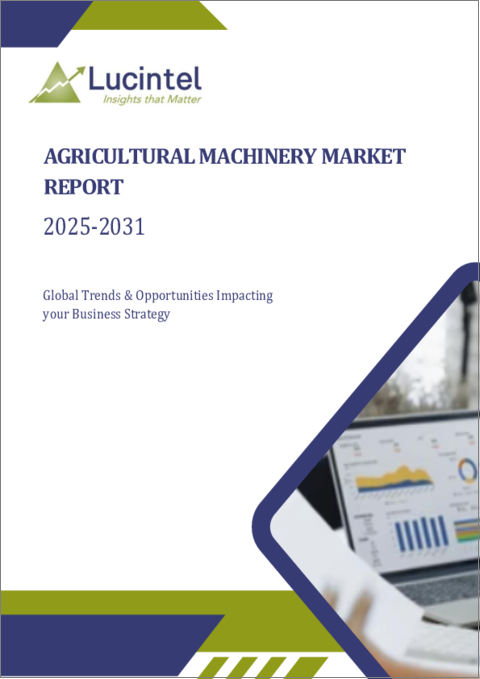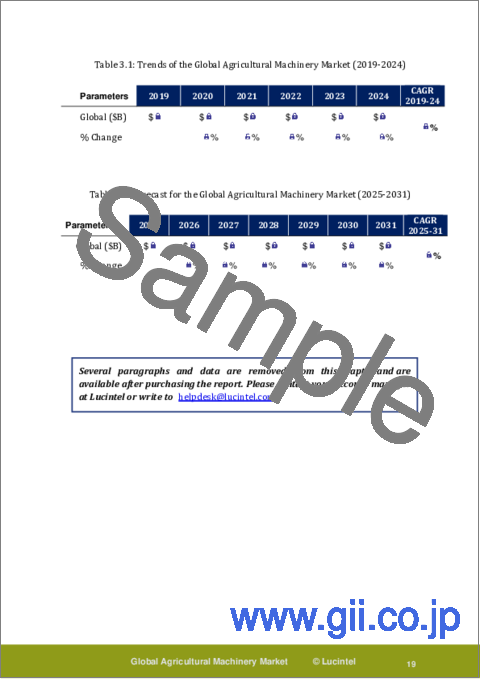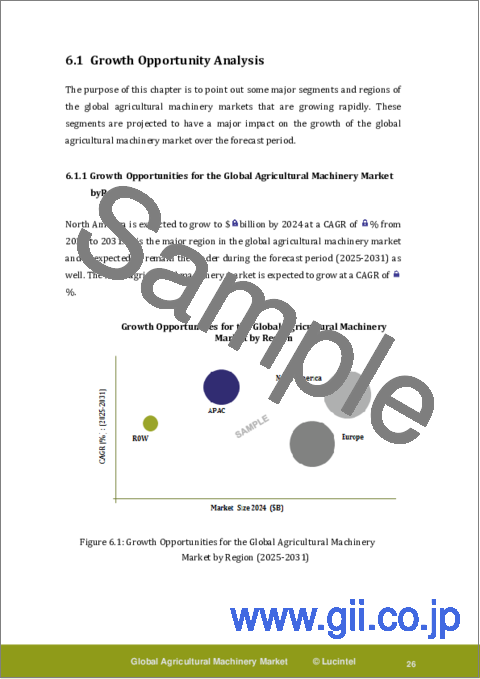|
|
市場調査レポート
商品コード
1603619
農業機械市場レポート:動向、予測、競合分析 (2030年まで)Agricultural Machinery Market Report: Trends, Forecast and Competitive Analysis to 2030 |
||||||
カスタマイズ可能
適宜更新あり
|
|||||||
| 農業機械市場レポート:動向、予測、競合分析 (2030年まで) |
|
出版日: 2024年11月25日
発行: Lucintel
ページ情報: 英文 150 Pages
納期: 3営業日
|
- 全表示
- 概要
- 目次
農業機械の動向と予測
世界の農業機械市場の将来は、開墾・苗床準備、播種・植え付け、草本栽培、植物保護、収穫・脱穀、ポストハーベスト・農産物加工市場において有望です。世界の農業機械市場は、2024年から2030年にかけてCAGR 5.7%で成長すると予想されます。この市場の主な促進要因は、農業分野での機械化の進展と農家の収入増です。
- Lucintelの予測では、製品カテゴリーでは、農業における生産性向上への需要の高まりにより、トラクターが予測期間中最大のセグメントであり続けます。
- 用途別では、開墾・苗床準備が引き続き最大セグメントとなります。
- 地域別では、北米の農業機械化需要の高まりにより、予測期間中北米が最も高い成長を遂げると予想されます。
農業機械市場の戦略的成長機会
農業機械市場における主要な戦略的機会には、以下のようなものがある:
- 精密農業機械:農作業の精度と効率の向上は、精密農業機械の利点のひとつであり、大きな成長機会となります。GPS、センサー、その他の技術は、作物の植え付け、施肥、灌漑の最適化に役立ち、資源の使用を最小限に抑えながら収穫量の増加につながります。
- 自律型機械:自動運転トラクターや収穫機などの自律型機械は、さらなる成長が見込まれます。これらの技術は人件費を削減し、作業効率を向上させることで、労働力不足に対処し、農業の生産性を高めます。
- 持続可能な農業ソリューション:環境への影響を最小限に抑える持続可能な農業機械への需要が高まっています。技術革新の焦点は、排出ガスを削減した代替燃料によってエネルギー消費を抑えるエンジンにあります。これにより、企業は世界の持続可能性目標に沿うことができ、環境意識の高い顧客を引き付けることができます。
- スマート農業技術:IoTやリアルタイムのデータ分析を含むスマートテクノロジーの統合は、成長の機会を生み出しています。これらの技術は、機器の性能監視を強化し、オペレーションを最適化し、農家に実用的な洞察を提供することで、効率性と収益性を向上させます。
- 手頃な価格で入手可能な機械:零細農家が手ごろな価格の機械を利用できるようにすることは、大きな機会となります。多機能でコンパクト、かつ手頃な価格の機械は、生産量を増やし、生産性を向上させ、世界の未開発地域の零細農家を支援することができます。
こうした戦略的成長機会は、農業機械がイノベーションに貢献し、農業における現代の課題に対処できる分野を示しています。この点で、精密農業、自律型機械、持続可能性、スマート技術、手頃な価格といった市場促進要因が市場の将来を形成しています。
農業機械市場の促進要因・課題
農業機械産業は、その成長と発展に影響を与える様々な要因の影響を受けています。技術の進歩、経済状況、規制などの要因がこの業界の形成に重要な役割を果たしています。
農業機械市場を牽引する要因は以下の通り:
- 技術の進歩:自動化、ロボット工学、スマート技術の革新が農業機械市場の成長を促進しています。これらの進歩は、現代農業の変化するニーズに対応するため、作業効率を高め、精度を向上させ、生産性を向上させます。
- 効率性への要求の高まり:効率性と生産性の向上に対するニーズが、この分野の拡大に大きく寄与しています。先進的な機器は、人件費を最小限に抑え、資源の有効利用を促進し、作物収量の増加につながります。
- 持続可能性の重視:持続可能な農業機械を開発する必要性が高まっています。エネルギー効率の高いエンジン、代替燃料、排出ガスの削減は、世界の持続可能性目標に合致しており、環境意識の高い顧客を惹きつけています。
- 精密農業の成長:世界中の農場で精密技術の応用が進んでいるため、先進的な機械の需要が高まっています。GPSガイド付き機器は、データ分析ツールとともに、より正確な農作業をサポートし、資源利用と作物の成果を向上させます。
- 拡大する新興市場:新興市場における農業機械の拡大は、今後の成長の大きな可能性を示しています。発展途上地域では、農業生産性を向上させるために新技術の導入が進んでおり、農業を通じて経済発展を支えています。
農業機械市場における課題は以下の通り:
- 先端技術の高コスト:高度に洗練された農業技術のコストは、特に小規模農家にとっては法外なものです。導入コストが高いため、最新機器へのアクセスが妨げられ、導入が制限される場合もあります。
- 規制への対応:複雑な安全基準や環境要件への対応は大きな課題です。地域によって多様な規制が存在するため、コンプライアンスを確保するために多大な資源投資が必要となります。
- 市場競争:農業機械市場は競争が激しく、数多くの企業が同様の製品を提供しています。製品を差別化し競争優位性を維持するためには、企業は継続的なイノベーションと効果的なマーケティング戦略を必要とします。
農業機械産業の発展に影響を与える促進要因と課題は、その成長軌道を決定づけます。企業がこの分野で成功するためには、技術、効率、持続可能性、市場力学に取り組むと同時に、コスト、規制遵守、競争に関する課題を克服しなければなりません。
目次
第1章 エグゼクティブサマリー
第2章 世界の農業機械市場:市場力学
- イントロダクション、背景、分類
- サプライチェーン
- 業界の促進要因と課題
第3章 市場動向と予測分析 (2018年~2030年)
- マクロ経済動向 (2018~2023年) と予測 (2024~2030年)
- 世界の農業機械市場の動向 (2018~2023年) と予測 (2024~2030年)
- 世界の農業機械市場:製品別
- トラクター
- 収穫機
- 植栽設備
- 灌漑・作物処理機器
- 噴霧装置
- 干草・飼料用機器
- その他
- 世界の農業機械市場:用途別
- 開墾・苗床整備
- 播種・植え付け
- 草本栽培
- 植物保護
- 収穫・脱穀
- ポストハーベスト・農産物加工
第4章 地域別の市場動向と予測分析 (2018年~2030年)
- 世界の農業機械市場:地域別
- 北米の農業機械市場
- 欧州の農業機械市場
- アジア太平洋の農業機械市場
- その他地域の農業機械市場
第5章 競合分析
- 製品ポートフォリオ分析
- 運用統合
- ポーターのファイブフォース分析
第6章 成長機会と戦略分析
- 成長機会分析
- 世界の農業機械市場の成長機会:製品別
- 世界の農業機械市場の成長機会:用途別
- 世界の農業機械市場の成長機会:地域別
- 世界の農業機械市場の新たな動向
- 戦略的分析
- 新製品の開発
- 世界の農業機械市場の生産能力拡大
- 世界の農業機械市場における企業合併・買収 (M&A)、合弁事業
- 認証とライセンシング
第7章 主要企業のプロファイル
- AGCO
- FlieglAgro-Center
- Agromaster
- Amazone
- APV
- Bellota Agrisolutions
- CLAAS KGaAmbH
- CNH Industrial
- Deere & Company
- Escorts
Agricultural Machinery Trends and Forecast
The future of the global agricultural machinery market looks promising with opportunities in land development & seed bed preparation, sowing & planting, weed cultivation, plant protection, harvesting & threshing, and post-harvest & agro-processing markets. The global agricultural machinery market is expected to grow with a CAGR of 5.7% from 2024 to 2030. The major drivers for this market are the growing mechanization in the agriculture sector and a rise in farmers' income.
- Lucintel forecasts that, within the product category, tractors will remain the largest segment over the forecast period due to rising demand for enhancing productivity in the agriculture industry.
- Within the application category, land development and seedbed preparation will remain the largest segment.
- In terms of regions, North America is expected to witness the highest growth over the forecast period due to increasing demand for farm mechanization in the region.
Gain valuable insights for your business decisions with our comprehensive 150+ page report.
Emerging Trends in the Agricultural Machinery Market
Emerging trends in the agricultural machinery market are reshaping its future applications and dynamics:
- Automation and Robotics: Automation as well as robotics are increasingly becoming significant features of farm machinery. Autonomous tractors, combines, and drones are transforming agriculture by reducing the need for human labor while enhancing operations. Such technologies ensure accurate farming practices driven by data, resulting in increased productivity and reduced costs.
- Precision Agriculture: Precision farming employs GPS, IoT, and data analytics to enhance farming activities. It encompasses the use of tools such as guidance systems for planting, fertilizing, or irrigating, ensuring high yields with minimal input. As a result, there is increasing usage of advanced sensors and mapping devices.
- Sustainability and Eco-Friendly Design: The manufacture of sustainable, environmentally friendly agricultural equipment has become paramount globally. This includes solutions such as energy-efficient engines and biofuels alternatives that reduce emissions. These trends promote global environmental goals while mitigating the impact of farming on the ecological footprint.
- Smart Connectivity and Data Integration: Machinery now comes equipped with smart connectivity features, allowing for real-time data collection and analysis. In addition to real-time monitoring, these systems include cloud-based platforms that oversee equipment performance, thereby facilitating better decision-making and improving operational efficiency.
- Affordability and Accessibility: The focus is on making agricultural machinery more affordable and accessible, particularly for smallholder farmers in developing countries. These developments include cost-effective, compact, multitasking equipment aimed at improving output without requiring substantial investment.
These emerging trends are changing the market for farm machinery by stimulating innovation and addressing contemporary farming challenges. Automation, precision agriculture, sustainability, smart connectivity, and cost-effectiveness are among the key factors determining its evolution.
Recent Developments in the Agricultural Machinery Market
Ongoing innovations and advancements in the agricultural machinery market have been highlighted:
- Autonomous Tractors: The introduction of autonomous tractors in agriculture has brought about significant changes by reducing manual labor and enhancing operating efficiency. With advanced sensors, GPS technology, and AI, these tractors can perform tasks such as plowing, planting, or harvesting with minimal human assistance.
- Precision Agriculture Tools: Farming practices are being enhanced through precision agriculture tools, including GPS-guided machinery coupled with data analytics platforms. These tools allow for accurate planting and fertilizing while ensuring proper irrigation, leading to improved crop yields and better resource management.
- Sustainable Equipment Innovations: Increasing attention is being directed toward the sustainable design of agricultural equipment. Innovations include energy-efficient engines, diversified fuel sources, and machines that emit fewer gases, aligning with global sustainability goals.
- Smart Connectivity: Agricultural machinery continues to integrate smart connectivity features into their systems. IoT and cloud-based platforms ensure the real-time collection and analysis of data, improving performance monitoring and farming decision-making processes.
- Cost-Effective Solutions: There is an increasing market for budget-friendly farm equipment designed specifically for smallholder farms. This includes multifunctional compact devices that aim to increase productivity and accessibility without requiring substantial capital investment.
These advances are improving the farming machinery market by introducing new technologies and enhancing efficiency. The growth of autonomous tractors, precision tools, sustainable innovations, smart connectivity, and cost-effective solutions is driving this evolution.
Strategic Growth Opportunities for Agricultural Machinery Market
Some key strategic opportunities in the agricultural machinery market include:
- Precision Farming Equipment: The increased accuracy and efficiency of farming practices are among the benefits of precision farming equipment, which offers significant growth opportunities. GPS, sensors, and other technologies help optimize planting, fertilizing, and irrigating crops, leading to increased yields while minimizing resource use.
- Autonomous Machinery: Autonomous machinery, such as self-driving tractors or harvesters, is expected to experience further growth. These technologies reduce labor costs and improve operational efficiency, addressing labor shortages and enhancing productivity in agriculture.
- Sustainable Agricultural Solutions: There is growing demand for sustainable agricultural machinery that minimizes environmental impact. Innovations are focused on engines that consume less energy through alternative fuels with reduced emissions. This allows companies to align with global sustainability goals and attract environmentally conscious customers.
- Smart Agriculture Technologies: The integration of smart technologies, including IoT and real-time data analytics, has created opportunities for growth. These technologies boost equipment performance monitoring, optimize operations, and provide actionable insights for farmers, improving their efficiency and profitability.
- Affordable and Accessible Machinery: Making affordable machinery available to smallholder farmers represents a significant business opportunity. Multifunctional, compact, and affordable equipment can increase output, improve productivity, and support smallholders in underdeveloped parts of the world.
These strategic growth opportunities indicate areas in which agricultural machinery can contribute to innovation and address modern challenges in agriculture. In this regard, market drivers such as precision farming, autonomous machinery, sustainability, smart technologies, and affordability are shaping the future of the market.
Agricultural Machinery Market Driver and Challenges
The agricultural machinery industry is influenced by various factors that impact its growth and development. Factors such as technological advancements, economic conditions, and regulations play a significant role in shaping this industry.
The factors responsible for driving the agricultural machinery market include:
- Technological Advancements: Innovations in automation, robotics, and smart technologies are driving growth in the agricultural machinery market. These advancements boost operational efficiencies, increase precision, and improve productivity to meet the changing needs of modern agriculture.
- Increasing Demand for Efficiency: The need for enhanced efficiency and productivity has significantly contributed to the expansion of this field. Advanced equipment minimizes labor costs, promotes better resource utilization, and leads to increased crop yields.
- Focus on Sustainability: The need to develop sustainable agricultural machinery is increasing. Energy-efficient engines, alternative fuels, and reduced emissions align with global sustainability goals, attracting environmentally conscious customers.
- Growth in Precision Agriculture: Advanced machinery is in high demand due to the rise of precision technology applications on farms worldwide. GPS-guided equipment, along with data analytics tools, supports more accurate farming practices, improving resource utilization and crop outcomes.
- Expanding Emerging Markets: The expansion of agricultural machinery in emerging markets presents significant potential for future growth. Developing regions are increasingly adopting new technologies to raise their agricultural productivity, thus supporting economic progress through farming.
Challenges in the agricultural machinery market include:
- High Cost of Advanced Technologies: The cost of highly sophisticated agri-tech can be prohibitive, especially for small-scale farmers. Adoption may be limited by high start-up costs, impeding access to up-to-date equipment.
- Regulatory Compliance: Navigating complex safety standards and environmental requirements poses significant challenges. Diverse regulations across regions require substantial investments in resources to ensure compliance.
- Market Competition: The agricultural machinery market is highly competitive, with numerous players offering similar products. To differentiate their products and maintain a competitive advantage, companies need continuous innovation and effective marketing strategies.
The drivers and challenges affecting the development of the agricultural machinery industry will define its growth trajectory. For a company to succeed in this field, it must address technological, efficiency, sustainability, and market dynamics while overcoming challenges related to cost, regulatory compliance, and competition.
List of Agricultural Machinery Companies
Companies in the market compete on the basis of product quality offered. Major players in this market focus on expanding their manufacturing facilities, R&D investments, infrastructural development, and leverage integration opportunities across the value chain. With these strategies agricultural machinery companies cater increasing demand, ensure competitive effectiveness, develop innovative products & technologies, reduce production costs, and expand their customer base. Some of the agricultural machinery companies profiled in this report include-
- AGCO
- Flieglagro-Center
- Agromaster
- Amazone
- APV
- Bellota Agrisolutions
- ClAAS KGaAmbH
- CNH Industrial
- Deere & Company
- Escorts
Agricultural Machinery by Segment
The study includes a forecast for the global agricultural machinery by product, application, and region.
Agricultural Machinery Market by Product [Analysis by Value from 2018 to 2030]:
- Tractors
- Harvesters
- Planting Equipments
- Irrigation & Crop Processing Equipments
- Spraying Equipments
- Hay & Forage Equipments
- Others
Agricultural Machinery Market by Application [Analysis by Value from 2018 to 2030]:
- Land Development & Seed Bed Preparation
- Sowing & Planting
- Weed Cultivation
- Plant Protection
- Harvesting & Threshing
- Post-Harvest & Agro-Processing
Agricultural Machinery Market by Region [Shipment Analysis by Value from 2018 to 2030]:
- North America
- Europe
- Asia Pacific
- The Rest of the World
Country Wise Outlook for the Agricultural Machinery Market
Major players in the market are expanding their operations and forming strategic partnerships to strengthen their positions. The following highlights recent developments by major agricultural machinery producers in key regions: the USA, China, India, Japan, and Germany.
- United States: In the United States, automation combined with smart technology has led to major advancements in agricultural machinery. Innovations include self-driving tractors and precision tools that have improved efficiency and reduced labor costs. The use of data analytics and IoT has enabled more precise and optimized farming operations.
- China: China is focusing on automating its agricultural machinery to improve efficiency. Recent developments include AI-enabled smart tractors and combines. The government also plans to modernize agricultural methods to boost productivity.
- Germany: Sustainable agricultural machinery is the most advanced in Germany. This includes energy-efficient equipment and the use of alternative fuels, with highlights being energy-efficient devices and the application of renewable fuels. Additionally, German manufacturers prioritize precision agriculture technologies aimed at reducing resource consumption during the growing season, leading to higher crop yields.
- India: India has been striving toward producing affordable yet effective agricultural machinery to assist small-scale farmers. The focus is on low-cost but efficient farm implements such as compact tractors, which help increase productivity even when resources are limited.
- Japan: Japan is at the forefront of advanced agricultural machinery, with an emphasis on automation and robotics. Recent innovations include self-driving drones for crop surveillance and robots that plant or harvest crops. These technologies address labor shortages and help improve output levels.
Features of the Global Agricultural Machinery Market
Market Size Estimates: Agricultural machinery market size estimation in terms of value ($B).
Trend and Forecast Analysis: Market trends (2018 to 2023) and forecast (2024 to 2030) by various segments and regions.
Segmentation Analysis: Agricultural machinery market size by product, application, and region in terms of value ($B).
Regional Analysis: Agricultural machinery market breakdown by North America, Europe, Asia Pacific, and Rest of the World.
Growth Opportunities: Analysis of growth opportunities in different products, applications, and regions for the agricultural machinery market.
Strategic Analysis: This includes M&A, new product development, and competitive landscape of the agricultural machinery market.
Analysis of competitive intensity of the industry based on Porter's Five Forces model.
If you are looking to expand your business in this or adjacent markets, then contact us. We have done hundreds of strategic consulting projects in market entry, opportunity screening, due diligence, supply chain analysis, M & A, and more.
This report answers following 11 key questions:
- Q.1. What are some of the most promising, high-growth opportunities for the agricultural machinery market by product (tractors, harvesters, planting equipments, irrigation & crop processing equipments, spraying equipments, hay & forage equipments, and others), application (land development & seed bed preparation, sowing & planting, weed cultivation, plant protection, harvesting & threshing, and post-harvest & agro-processing), and region (North America, Europe, Asia Pacific, and the Rest of the World)?
- Q.2. Which segments will grow at a faster pace and why?
- Q.3. Which region will grow at a faster pace and why?
- Q.4. What are the key factors affecting market dynamics? What are the key challenges and business risks in this market?
- Q.5. What are the business risks and competitive threats in this market?
- Q.6. What are the emerging trends in this market and the reasons behind them?
- Q.7. What are some of the changing demands of customers in the market?
- Q.8. What are the new developments in the market? Which companies are leading these developments?
- Q.9. Who are the major players in this market? What strategic initiatives are key players pursuing for business growth?
- Q.10. What are some of the competing products in this market and how big of a threat do they pose for loss of market share by material or product substitution?
- Q.11. What M&A activity has occurred in the last 5 years and what has its impact been on the industry?
Table of Contents
1. Executive Summary
2. Global Agricultural Machinery Market : Market Dynamics
- 2.1: Introduction, Background, and Classifications
- 2.2: Supply Chain
- 2.3: Industry Drivers and Challenges
3. Market Trends and Forecast Analysis from 2018 to 2030
- 3.1. Macroeconomic Trends (2018-2023) and Forecast (2024-2030)
- 3.2. Global Agricultural Machinery Market Trends (2018-2023) and Forecast (2024-2030)
- 3.3: Global Agricultural Machinery Market by Product
- 3.3.1: Tractors
- 3.3.2: Harvesters
- 3.3.3: Planting Equipments
- 3.3.4: Irrigation & Crop Processing Equipments
- 3.3.5: Spraying Equipments
- 3.3.6: Hay & Forage Equipments
- 3.3.7: Others
- 3.4: Global Agricultural Machinery Market by Application
- 3.4.1: Land Development & Seed Bed Preparation
- 3.4.2: Sowing & Planting
- 3.4.3: Weed Cultivation
- 3.4.4: Plant Protection
- 3.4.5: Harvesting & Threshing
- 3.4.6: Post-harvest & Agro-processing
4. Market Trends and Forecast Analysis by Region from 2018 to 2030
- 4.1: Global Agricultural Machinery Market by Region
- 4.2: North American Agricultural Machinery Market
- 4.2.1: North American Market by Product: Tractors, Harvesters, Planting Equipments, Irrigation & Crop Processing Equipments, Spraying Equipments, Hay & Forage Equipments, and Others
- 4.2.2: North American Market by Application: Land Development & Seed Bed Preparation, Sowing & Planting, Weed Cultivation, Plant Protection, Harvesting & Threshing, and Post-harvest & Agro-processing
- 4.3: European Agricultural Machinery Market
- 4.3.1: European Market by Product: Tractors, Harvesters, Planting Equipments, Irrigation & Crop Processing Equipments, Spraying Equipments, Hay & Forage Equipments, and Others
- 4.3.2: European Market by Application: Land Development & Seed Bed Preparation, Sowing & Planting, Weed Cultivation, Plant Protection, Harvesting & Threshing, and Post-harvest & Agro-processing
- 4.4: APAC Agricultural Machinery Market
- 4.4.1: APAC Market by Product: Tractors, Harvesters, Planting Equipments, Irrigation & Crop Processing Equipments, Spraying Equipments, Hay & Forage Equipments, and Others
- 4.4.2: APAC Market by Application: Land Development & Seed Bed Preparation, Sowing & Planting, Weed Cultivation, Plant Protection, Harvesting & Threshing, and Post-harvest & Agro-processing
- 4.5: ROW Agricultural Machinery Market
- 4.5.1: ROW Market by Product: Tractors, Harvesters, Planting Equipments, Irrigation & Crop Processing Equipments, Spraying Equipments, Hay & Forage Equipments, and Others
- 4.5.2: ROW Market by Application: Land Development & Seed Bed Preparation, Sowing & Planting, Weed Cultivation, Plant Protection, Harvesting & Threshing, and Post-harvest & Agro-processing
5. Competitor Analysis
- 5.1: Product Portfolio Analysis
- 5.2: Operational Integration
- 5.3: Porter's Five Forces Analysis
6. Growth Opportunities and Strategic Analysis
- 6.1: Growth Opportunity Analysis
- 6.1.1: Growth Opportunities for the Global Agricultural Machinery Market by Product
- 6.1.2: Growth Opportunities for the Global Agricultural Machinery Market by Application
- 6.1.3: Growth Opportunities for the Global Agricultural Machinery Market by Region
- 6.2: Emerging Trends in the Global Agricultural Machinery Market
- 6.3: Strategic Analysis
- 6.3.1: New Product Development
- 6.3.2: Capacity Expansion of the Global Agricultural Machinery Market
- 6.3.3: Mergers, Acquisitions, and Joint Ventures in the Global Agricultural Machinery Market
- 6.3.4: Certification and Licensing
7. Company Profiles of Leading Players
- 7.1: AGCO
- 7.2: FlieglAgro-Center
- 7.3: Agromaster
- 7.4: Amazone
- 7.5: APV
- 7.6: Bellota Agrisolutions
- 7.7: CLAAS KGaAmbH
- 7.8: CNH Industrial
- 7.9: Deere & Company
- 7.10: Escorts





